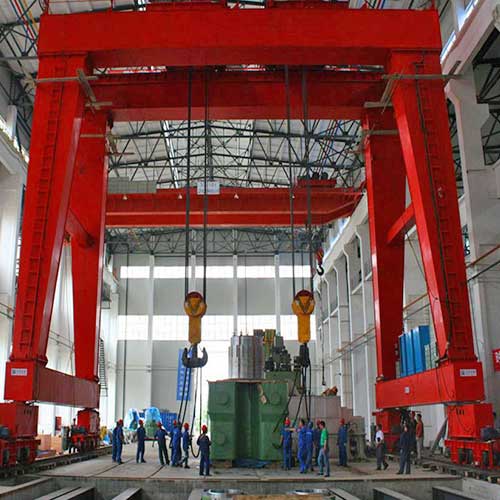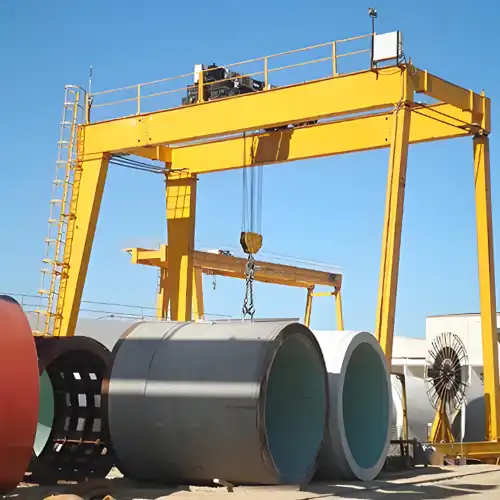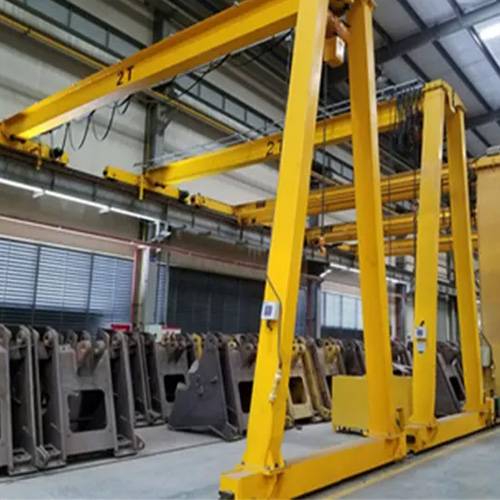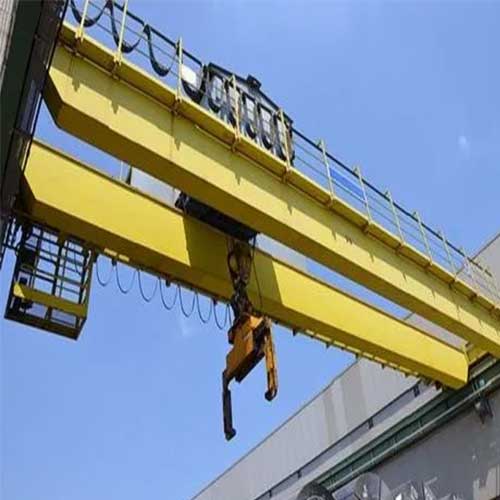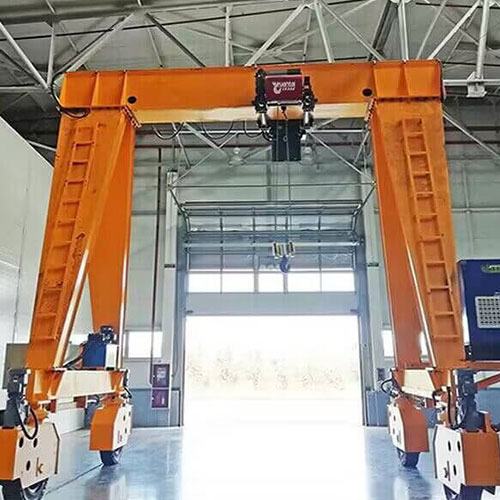Comprehensive Guide to Factory Gantry Cranes: Select Right Cranes
Factroy gantry cranes for sale. Custom gantry crane with single girder & double girder for various industrial factory and plants. Get your custom factory crane!
Category: Factory Crane
Your Trusted Factory Crane Manufacturer & Supplier
Comprehensive Guide to Factory Gantry Cranes: Select Right Cranes
Factory gantry cranes stand as the backbone of material handling in various industrial sectors, providing an efficient and reliable means of transporting heavy loads within the workspace. These cranes are versatile, designed to lift and move objects horizontally, making them indispensable assets for optimizing production processes.
Gantry cranes typically consist of a horizontal beam supported by two upright legs, running on wheels or along a track. Their flexibility in movement, coupled with impressive load-bearing capacities, makes them invaluable across a wide array of industries.
Importance of Choosing the Right Gantry Crane for Specific Industrial Needs
Selecting the right gantry crane is a pivotal decision for any factory, directly impacting operational efficiency, safety, and overall productivity. Different industries have distinct requirements, and finding a crane that aligns with those needs is essential. The right gantry crane not only enhances lifting capabilities but also contributes to the longevity of machinery and ensures a smoother workflow.
A well-matched gantry crane can optimize processes, minimize downtime, and reduce the risk of accidents, providing a significant return on investment. Understanding the nuances of various crane types and their suitability to specific tasks is crucial for making an informed decision.
This comprehensive guide is tailored for buyers seeking expert guidance in their quest to purchase gantry cranes for their factories. Whether you're planning to install a new gantry crane system or upgrading an existing one, this guide will navigate you through the intricate details of choosing the right crane type, considering factors such as factory size, working environment, and specific industry requirements.
Types of Factory Gantry Cranes
Single Girder Gantry Cranes
Single girder factory gantry cranes are characterized by their simple yet robust design, comprising a single horizontal beam supported by two upright legs. The crane's hoist is mounted on the girder, facilitating vertical movement for lifting and lowering loads. These cranes can be either stationary or mobile, running on tracks or wheels, offering versatility in their applications.
Key features:
Single Girder Structure: One main horizontal beam supporting the hoist and trolley.
Upright Legs: Two vertical legs provide stability and support.
Hoisting Mechanism: Efficient hoisting capability for vertical load movement.
Versatility: Suitable for various lifting tasks in different environments.
Suitable Industries and Applications
Single girder factory gantry cranes find applications across a spectrum of industries due to their adaptability and cost-effectiveness. Industries include:
Warehousing: Ideal for lifting and moving goods within warehouses.
Manufacturing: Suited for light to moderate lifting in production processes.
Construction: Used for handling materials on construction sites.
Automotive: Efficient for assembly line processes and component handling.
Advantages and Limitations
Advantages:
Cost-Effective: Generally more economical to purchase and install.
Versatility: Well-suited for a wide range of lifting tasks.
Space-Efficient: Takes up less space compared to double girder cranes.
Ease of Installation: Quick and straightforward setup.
Limitations:
Lower Capacity: Typically has a lower lifting capacity compared to double girder cranes.
Span Limitations: Limited span width for larger applications.
Less Stability: May have reduced stability for heavier loads.
Types of single girder factory gantry cranes
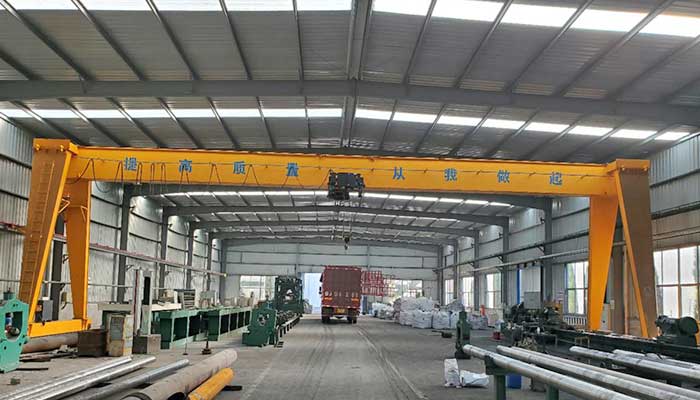
Single Girder Factory Gantry Crane with Electric Hoists Wire Rope Types
Description: Electric wire rope hoists are powered by electricity and use a system of pulleys and steel ropes to lift and lower loads. They provide precise control, higher lifting capacities, and are suitable for applications where accuracy and speed are crucial.
Advantages:
High lifting capacities.
Precise positioning and control.
Suitable for longer lifting heights.
Can handle a variety of load sizes and shapes.
Applications:
Manufacturing facilities with heavy and irregularly shaped loads.
Construction sites where versatility and high capacities are required.
Workshops with the need for efficient material handling.
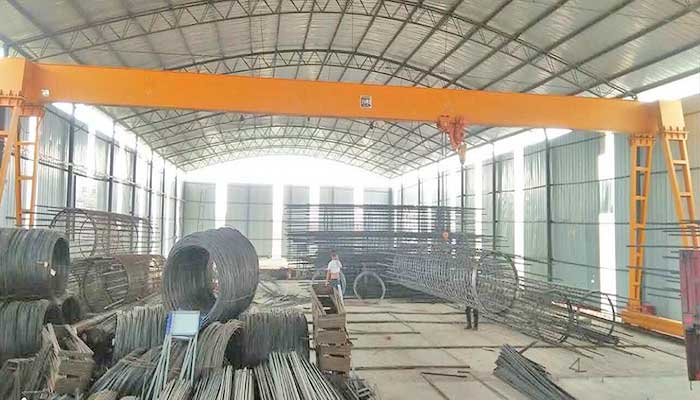
Single Girder Factory Gantry Crane with Chain Hoist:
Description: Chain hoists use a chain to lift and lower loads. They are typically powered by electricity and are known for their simplicity, durability, and suitability for lighter loads and shorter lifting heights.
Advantages:
Simplicity of design and operation.
Suitable for lighter loads and shorter lifting heights.
Cost-effective solution.
Minimal maintenance requirements.
Applications:
Light manufacturing processes.
Warehouses with moderate lifting requirements.
Maintenance and repair workshops.
Applications where cost-effectiveness is a priority.
Choosing between electric wire rope hoists and chain hoists depends on the specific needs of your lifting operation. Factors such as load characteristics, lifting height, speed requirements, and budget considerations play a significant role in determining the most suitable hoist type for your single girder gantry crane. Consulting with crane experts or suppliers can help in making an informed decision based on the unique requirements of your factory or workspace.

Single Girder Gantry Crane with A-Frame Legs:
Description: The A-frame design involves the support legs forming an "A" shape on either side of the gantry crane. This configuration offers stability and is commonly used for light to moderate lifting applications.
Applications: Suitable for workshops, warehouses, and outdoor locations where a stable structure is required.

Single Girder Gantry Crane with L-Shaped Legs:
Description: The L-shaped leg design features legs that extend perpendicular to the ground, forming an "L" shape. This configuration provides stability and is often used for medium to heavy-duty lifting applications.
Applications: Commonly found in manufacturing facilities, steel yards, and construction sites where heavier loads need to be lifted.
It's essential to note that the terminology might vary across regions and manufacturers. The structure and leg design are critical factors in determining the crane's stability, load capacity, and suitability for specific applications. When considering a single girder gantry crane, it's recommended to consult with crane manufacturers or suppliers to ensure that the chosen design meets the specific requirements of your factory or workspace.
Double Girder Gantry Cranes
Double girder gantry cranes are characterized by their robust design, featuring two horizontal beams (girders) supported by upright legs. The hoisting mechanism is mounted between the girders, providing increased stability and lifting capacity. This design allows for the efficient handling of heavier loads across longer spans.
Key features:
Dual Girder Structure: Two main horizontal beams for enhanced stability.
Upright Legs: Provide strong support and stability for heavier loads.
Hoisting Mechanism: Positioned between the girders for optimal lifting capabilities.
High Lifting Capacity: Capable of handling heavier loads than single girder cranes.
Appropriate Industries and Use Cases
Double girder gantry cranes are well-suited for industries and applications that demand high lifting capacities and larger spans. These include:
Steel and Metal Manufacturing: Handling heavy raw materials and finished products.
Shipbuilding: Efficiently moving large ship components during construction.
Power Plants: Lifting and transporting heavy machinery and components.
Heavy Equipment Manufacturing: Maneuvering oversized components in production.
Key Advantages and Considerations
Advantages:
High Lifting Capacity: Capable of lifting significantly heavier loads.
Extended Span: Suitable for applications requiring a larger working area.
Durability: Robust design ensures longevity and resistance to wear.
Versatility: Adaptable to various industrial processes and applications.
Considerations:
Higher Cost: Typically involves a higher initial investment compared to single girder cranes.
Installation Complexity: Requires more complex installation and maintenance procedures.
Space Requirements: Due to larger spans, they may require more space for operation.
Types of Double Girder Factory Gantry Cranes
Double girder factory gantry cranes are robust lifting solutions designed for heavy-duty applications. They come in various configurations to accommodate different requirements. Let's explore the types you mentioned:
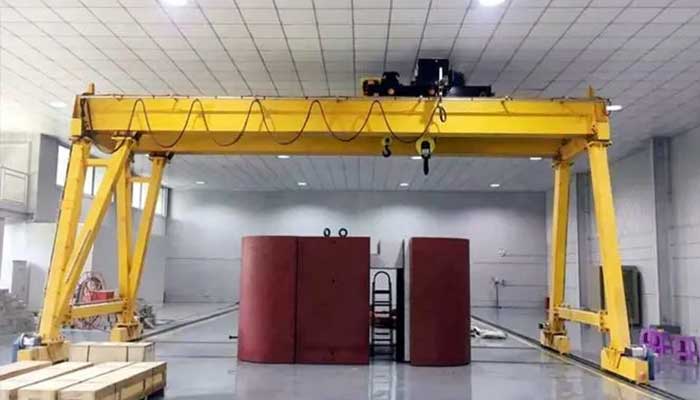
Double Girder Factory Gantry Crane with Electric Hoists and Trolley:
Description: This type of gantry crane features two horizontal girders running parallel to each other with an electric hoist and trolley system between them. The hoist and trolley are responsible for vertical and horizontal movement of the load, providing precise control and flexibility.
Advantages:
High lifting capacities.
Precise load positioning.
Versatility for handling various load sizes and shapes.
Efficient material handling in heavy industries.
Applications:
Steel manufacturing plants.
Heavy machinery workshops.
Construction sites with large and heavy loads.
Warehouses with high-capacity lifting needs.
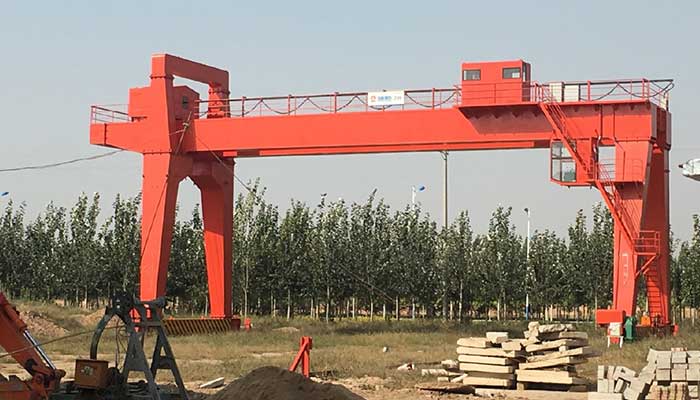
Double Girder Factory Gantry Crane with Open Winch Trolley:
Description: This type of gantry crane features an open winch trolley system suspended between the double girders. The open winch design allows for easy maintenance and accessibility. It is suitable for heavy-duty applications.
Advantages:
Excellent lifting capacity.
Easy accessibility for maintenance.
Versatility for handling various load types.
Ideal for continuous operation in demanding environments.
Applications:
Container yards for handling heavy containers.
Foundries and steel mills.
Shipbuilding and maintenance yards.
Heavy machinery manufacturing.
Choosing between a gantry crane with electric hoists and trolley or an open winch trolley depends on specific application requirements. Both configurations offer high lifting capacities and are suitable for heavy-duty industries, but the choice may be influenced by factors such as maintenance preferences, duty cycle, and the nature of the loads being handled.
It's advisable to consult with crane manufacturers or suppliers to determine the most suitable double girder gantry crane configuration for your factory or industrial setting based on your unique operational needs.
Semi-Gantry Cranes
Semi-gantry cranes, also known as half-gantry cranes, are designed with a unique configuration where one end of the crane is supported by an overhead runway, while the other end travels on the floor via a set of wheels. This hybrid design allows for efficient material handling in specific scenarios where a full gantry system might be impractical.
Key features:
One Supported End: Supported by an overhead runway on one end.
Floor-Mounted Wheels: The opposite end travels on the floor for mobility.
Hoisting Mechanism: Positioned for vertical load movement.
Purpose:
Semi-gantry cranes are employed in situations where one side of the working area has a permanent support structure, such as a wall or column, making it advantageous for handling loads in a defined workspace.
Industries Benefiting from Semi-Gantry Cranes
Semi-gantry cranes find application in industries where a combination of overhead and floor-level lifting is necessary. Some of these industries include:
Manufacturing: Used for assembly processes where a portion of the production line requires overhead lifting.
Storage Facilities: Efficient for handling materials in storage yards with varying load points.
Workshops: Ideal for workshops with limited overhead clearance but requiring gantry crane functionality.
Loading Docks: Suited for areas where part of the workspace is covered by an overhead structure.
Operational Advantages and Limitations
Advantages:
Cost-Effective: Generally more economical than full gantry cranes.
Space Optimization: Well-suited for facilities with limited overhead space.
Flexibility: Offers a combination of overhead and floor-level lifting capabilities.
Maneuverability: Easily movable within the defined workspace.
Limitations:
Partial Coverage: Limited to the area covered by the overhead support structure.
Load Capacity: May have lower lifting capacity compared to full gantry cranes.
Installation Complexity: Requires careful planning to integrate with existing structures.
Types of Semi Frame Single Leg Factory Gantry Cranes
Semi gantry cranes, also known as half gantry cranes, feature one end supported by a wall or structure, while the other end moves on wheels along a runway or track. They come in both single girder and double girder configurations. Let's explore the types you mentioned:
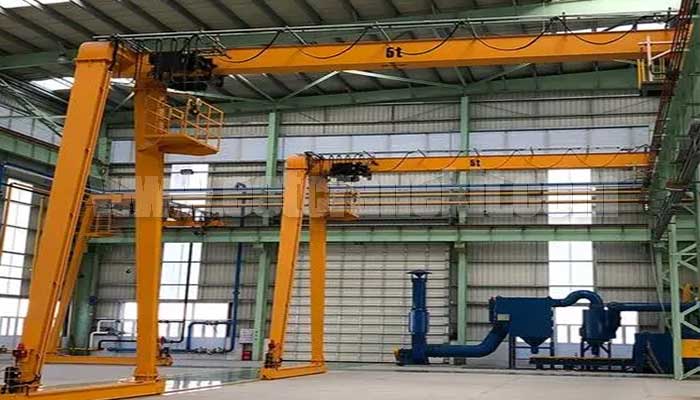
Single Girder Semi Gantry Crane:
Single Girder Semi Gantry Crane with Adjustable Height:
Description: This type of semi gantry crane with a single girder allows for the adjustment of the girder's height, providing versatility in handling loads of different sizes and accommodating varying ceiling clearances.
Advantages:
Adaptability to different load sizes.
Suitable for facilities with changing layout requirements.
Efficient material handling in variable environments.
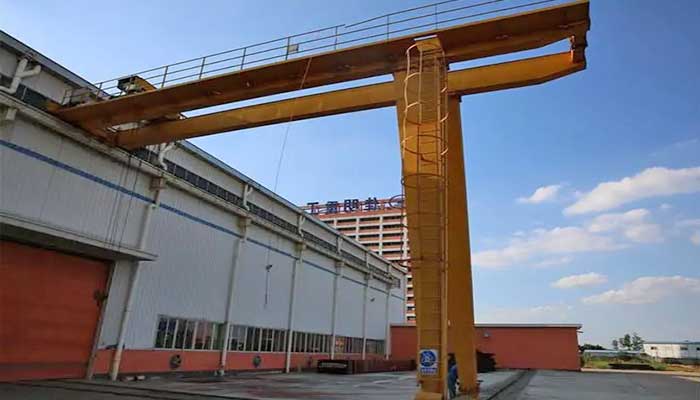
Double Girder Semi Gantry Crane:
Double Girder Semi Gantry Crane:
Description: This configuration features two girders with one end supported by the supporting structure, offering increased stability and lifting capacity compared to single girder semi gantry cranes.
Advantages:
Higher lifting capacities.
Enhanced stability for handling heavier loads.
Suitable for heavy-duty applications in industrial settings.
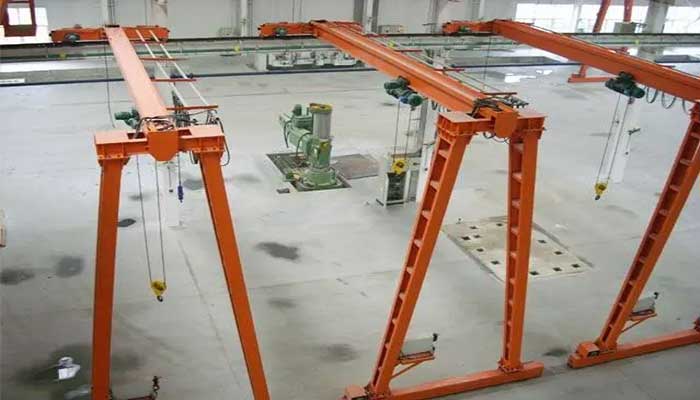
Single Girder Semi Gantry Crane with A-Frame Leg:
Description: This type of semi gantry crane has a single girder structure with one end supported by an A-frame leg, providing stability and support. The other end moves along the runway or track.
Advantages:
Suitable for applications with limited space on one side.
A-frame leg design enhances stability.
Versatile for various material handling tasks.

Single Girder Semi Gantry Crane with L Frame Leg:
Single Girder Semi Gantry Crane with L-Frame Leg:
Description: In this design, a single girder is supported by a L-shaped frame leg, providing stability and support at one end, while the other end travels along the runway or track.
Advantages:
L-frame leg design enhances stability and load-bearing capacity.
Suitable for applications with restricted space on one side.
Versatile for handling various material lifting tasks.
This configuration is particularly useful when the space on one side of the crane installation is limited, and the U-frame leg design ensures robust support for efficient material handling. The U-frame leg design offers stability, making it suitable for diverse industrial applications.
Portable Gantry Cranes
Portable gantry cranes are designed for maximum flexibility and ease of relocation, providing a versatile solution for lifting and moving loads within a workspace. These cranes typically feature a lightweight and modular design, allowing for quick assembly, disassembly, and transportation.
Key characteristics:
Modular Construction: Easily assembled and disassembled for mobility.
Adjustable Height: Variable height options for accommodating different load sizes.
Lightweight Materials: Constructed with materials that balance strength and portability.
Castor Wheels: Equipped with wheels for easy movement within the workspace.
Flexibility:
Portable gantry cranes offer the flexibility to set up temporary lifting solutions where needed.
They can be easily moved between workstations or different areas of a facility.
Ideal Applications and Industries
Portable gantry cranes are suitable for a variety of applications and industries where mobility and adaptability are essential. Some of the ideal use cases include:
Maintenance and Repair: Lifting equipment and materials for maintenance tasks.
Workshops and Small Manufacturing: Handling materials in small-scale production settings.
Outdoor Construction Sites: Providing on-site lifting capabilities without the need for a fixed crane.
Warehousing: Efficient for temporary material handling in warehouse environments.
Mobility and Installation Considerations
Mobility:
Wheel Configuration: Equipped with castor wheels for easy maneuverability.
Locking Mechanisms: Secure locking mechanisms to ensure stability during operation.
Transportability: Portable gantry cranes can be transported using standard equipment such as forklifts.
Installation:
Quick Assembly: Designed for rapid assembly and disassembly without specialized tools.
Adjustable Height: Easily adjustable to accommodate various lifting requirements.
Stability: Ensuring a stable base and proper leveling is essential for safe operation.
Types of Portable Factory Gantry Cranes
Portable gantry cranes are versatile lifting solutions that offer mobility and flexibility in various industrial applications. They come in different types to meet specific needs. Let's explore the types you mentioned:
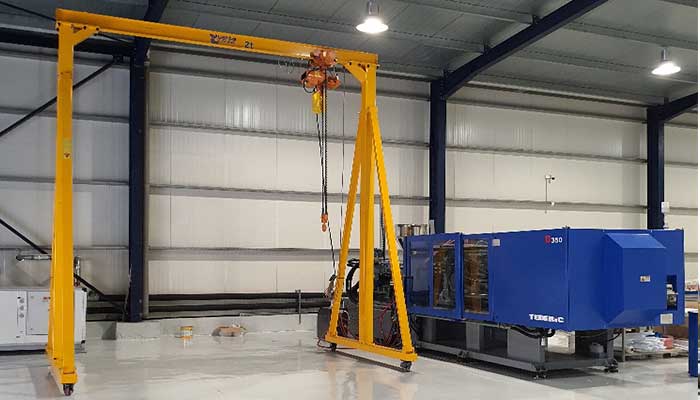
Fixed Height Portable Gantry Crane:
Description: This type of portable gantry crane has a fixed height, meaning the height of the vertical support columns cannot be adjusted. It provides stability and simplicity for lifting tasks within a specific height range.
Advantages:
Easy to set up and use.
Stable for lifting tasks at a consistent height.
Suitable for applications with uniform lifting requirements.
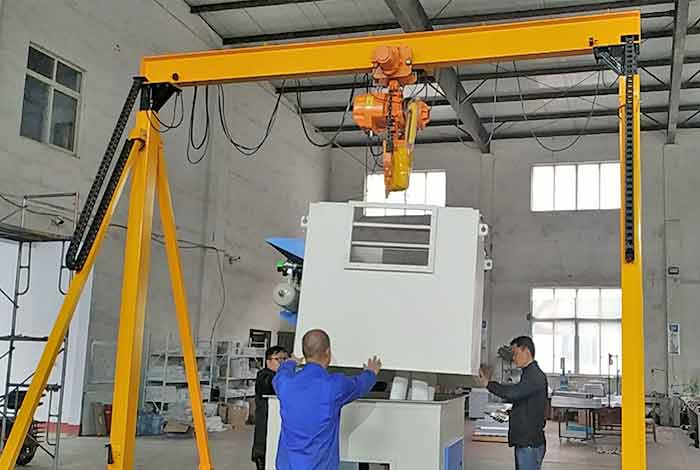
Adjustable Height Portable Gantry Crane:
Description: In contrast to the fixed height version, the adjustable height portable gantry crane allows users to modify the vertical height of the support columns. This flexibility is beneficial when lifting tasks require different vertical clearances.
Advantages:
Versatile for handling loads at various heights.
Adaptability to changing work environments.
Suitable for applications with varying lifting requirements.

Aluminum Portable Gantry Crane:
Description: This type of portable gantry crane is constructed from aluminum, making it lightweight and corrosion-resistant. Aluminum cranes are easy to move and suitable for environments where weight is a critical factor.
Advantages:
Lightweight and easily transportable.
Corrosion-resistant for durability.
Ideal for applications where crane weight is a concern.

Adjustable Span Portable Gantry Crane:
Description: The adjustable span portable gantry crane allows users to modify the span width between the support columns. This feature provides flexibility in adapting to different workspaces and layouts.
Advantages:
Suitable for handling loads in various working environments.
Adjustable span accommodates different material handling requirements.
Versatile for use in workshops, warehouses, and construction sites.
Portable gantry cranes are popular for their ease of mobility and quick setup, making them valuable assets in applications with changing lifting needs. The choice between fixed or adjustable height, aluminum construction, and adjustable span depends on the specific requirements of the lifting tasks and the working environment. Consulting with crane experts or suppliers can help determine the most suitable portable gantry crane configuration for your factory or industrial setting.
Factors Influencing Factory Gantry Crane Selection
Factory Size and Layout
Matching Crane Capacity to Factory Dimensions
Selecting an appropriate gantry crane involves a meticulous evaluation of the factory size and the spatial requirements for lifting operations. Key considerations include:
- Lifting Height: Ensure the crane's lifting height aligns with the vertical clearance within the factory. This prevents collisions with ceilings or other structures.
- Span Width: Determine the optimal span width, ensuring that the crane adequately covers the intended work area without obstruction.
- Floor Space: Assess the available floor space for the crane's movement, considering both the horizontal and vertical dimensions.
- Load Capacity: Choose a gantry crane with a lifting capacity that accommodates the heaviest loads typically handled within the factory. Be mindful of potential future load increases.
Adaptability to Different Layouts
The adaptability of a gantry crane to different factory layouts is essential for ensuring seamless integration into various work environments. Factors to consider include:
- Modular Design: Opt for gantry cranes with a modular design, allowing for adjustments and reconfigurations to suit changing layouts.
- Track Systems: Choose between fixed-track systems and those with more flexible wheel configurations, depending on the layout's permanence.
- Maneuverability: Assess the crane's maneuverability to navigate through different sections of the factory, ensuring it can reach all required workstations.
- Interference Considerations: Evaluate potential obstructions or spatial limitations that could affect the crane's movement within different layouts.
Working Environment

Dust-Free Environments
In environments where cleanliness is paramount, such as laboratories or certain manufacturing processes, opting for gantry cranes designed for dust-free environments is essential. Key considerations include:
- Enclosed Design: Choose cranes with enclosed components and sealed mechanisms to prevent dust ingress.
- Stainless Steel Construction: Utilize gantry cranes constructed from stainless steel, as it resists corrosion and is easy to clean.
- Smooth Surfaces: Select cranes with smooth surfaces to minimize dust accumulation and facilitate easy cleaning.
Dusty Environments and the Need for Protection
In contrast, dusty environments pose specific challenges that demand protective measures for gantry cranes. Consider the following:
- Dust Covers and Seals: Opt for cranes equipped with dust covers and seals to protect critical components from airborne particles.
- Regular Maintenance: Implement a proactive maintenance schedule to address dust buildup and prevent potential damage.
- Durable Finishes: Choose cranes with durable finishes, such as corrosion-resistant coatings, to withstand the abrasive nature of dust.
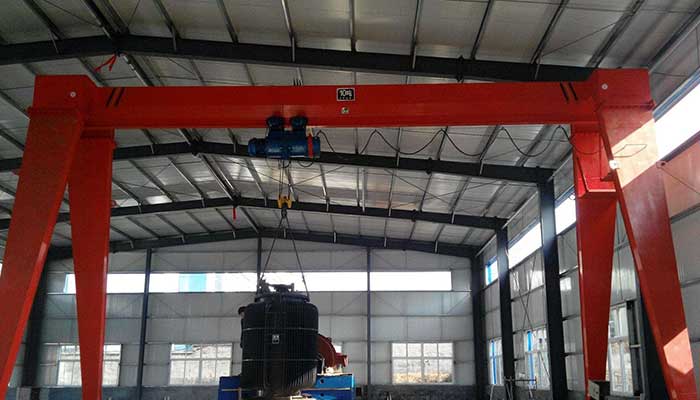
Explosion-Proof Gantry Cranes for Hazardous Areas
In industries where explosive atmospheres are a concern, such as chemical plants or oil refineries, explosion-proof gantry cranes are vital. Key features and considerations include:
- Explosion-Proof Components: Gantry cranes should be equipped with components designed to prevent the ignition of flammable substances in the atmosphere.
- Certifications: Ensure the crane meets industry-specific safety standards and certifications for hazardous environments.
- Spark-Resistant Materials: Select materials that reduce the risk of sparks or friction-generated heat, minimizing the potential for ignition.
Understanding and addressing the specific requirements of the working environment is critical for gantry crane selection. Whether it's a need for dust-free operations, protection in dusty environments, or compliance with safety standards in hazardous areas, choosing the right crane ensures optimal performance and longevity. In the subsequent sections, we will explore additional factors influencing gantry crane selection to guide buyers in making well-informed decisions.
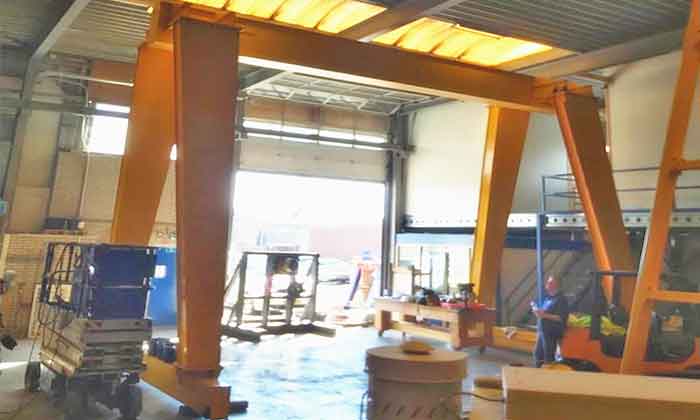
Space Constraints
Gantry Cranes for Limited Space
In scenarios where available space is limited, selecting gantry cranes tailored for constrained environments becomes crucial. Consider the following aspects:
- Compact Design: Opt for gantry cranes with a compact and space-saving design, ensuring they can operate efficiently in confined areas.
- Adjustable Height: Choose cranes with adjustable height features to accommodate varying ceiling clearances and maximize vertical space utilization.
- Foldable or Telescopic Features: Look for cranes with foldable or telescopic features that allow the crane to retract or collapse when not in use, freeing up valuable floor space.
- Minimal Footprint: Prioritize cranes with a minimal footprint to reduce the impact on the available workspace.
Suitable Designs for Cramped Environments
Selecting the right design for cramped environments involves considering the specific layout and challenges of the workspace. Key design features include:
- Single Leg Gantry Cranes: These cranes have one supporting leg, making them suitable for locations where space is restricted on one side. They provide optimal clearance on the other side.
- Wall-Mounted Gantry Cranes: Wall-mounted cranes are attached to existing structures, eliminating the need for floor space beneath the crane. Ideal for maximizing space efficiency.
- Trackless Gantry Cranes: Gantry cranes that operate without fixed tracks offer flexibility in movement, making them suitable for navigating tight spaces and avoiding obstacles.
Considering the space constraints and adopting a gantry crane design that aligns with the available workspace ensures optimal functionality without compromising efficiency. In the subsequent sections, we will explore additional factors influencing gantry crane selection to guide buyers in making well-informed decisions based on their specific industrial requirements.

Load Capacity and Size
Calculating Load Requirements
Determining the load capacity requirements is a critical step in selecting the right gantry crane. Accurate calculations ensure that the crane can handle the intended loads efficiently and safely. Consider the following factors:
- Weight of the Heaviest Load: Identify the maximum weight of the heaviest load the crane will be lifting. Include any potential future increases in load size.
- Load Distribution: Consider how the load is distributed. Ensure that the crane's capacity accounts for the load's center of gravity and any uneven weight distribution.
- Dynamic Factors: Factor in dynamic forces, such as acceleration and deceleration, which can impact the effective load capacity of the crane during operation.
- Environmental Conditions: Account for environmental factors like wind, temperature, or seismic conditions, which can influence load stability.
Choosing the Appropriate Crane Size
Selecting the right size of gantry crane involves matching its specifications with the calculated load requirements. Consider the following aspects:
- Span Width: Choose a gantry crane with an appropriate span width that covers the entire work area and allows for easy access to loads.
- Lifting Height: Ensure the crane's lifting height meets the vertical clearance requirements within the factory, preventing collisions with structures.
- Hoisting Speed: Evaluate the required hoisting speed to determine the crane's efficiency in handling loads within specific timeframes.
- Trolley Speed: Consider the trolley speed to ensure swift and precise horizontal movement of the load.
- Footprint: Assess the crane's footprint to ensure it fits within the available workspace without causing obstruction.
- Rail or Track Configuration: Choose between fixed rail or track systems or more flexible wheel configurations, depending on the application and layout.
By accurately calculating load requirements and selecting the appropriate gantry crane size, buyers can ensure the crane's optimal performance and longevity. In the subsequent sections, we will delve into other critical factors influencing gantry crane selection, providing comprehensive insights for buyers seeking to enhance their industrial operations.
Specific Considerations for Different Industrial Sectors
Automotive Industry
Specialized Requirements for Handling Heavy Loads
In the automotive industry, gantry cranes play a pivotal role in handling heavy and often irregularly shaped loads. Specific considerations for selecting gantry cranes in this sector include:
- High Load Capacity: Due to the substantial weight of automotive components, gantry cranes in the automotive industry must have a high load capacity to lift and maneuver items such as engines, chassis, and body parts.
- Precision and Control: The precise positioning of components during manufacturing processes requires gantry cranes with advanced control systems, ensuring accuracy in placement and assembly.
- Durability: Automotive manufacturing environments can be demanding, requiring gantry cranes with robust construction and materials that can withstand the rigors of continuous use.
Integration with Assembly Lines
Gantry cranes in the automotive industry often need to seamlessly integrate into assembly lines for efficient production. Key considerations include:
- Synchronized Operation: Gantry cranes must operate in sync with assembly line processes, ensuring a smooth flow of materials and minimizing production delays.
- Adaptability: The ability of gantry cranes to adapt to changing assembly line layouts and production requirements is crucial for maintaining flexibility in manufacturing processes.
- Automation Compatibility: Integrating gantry cranes with automation systems can enhance efficiency and reduce manual intervention, improving overall productivity on the assembly line.
- Safety Features: Gantry cranes should be equipped with advanced safety features to protect both workers and products during assembly processes.
To know the specialized requirements of the automotive industry is essential for selecting gantry cranes that contribute to efficient production, seamless integration, and overall operational success. In the subsequent sections, we will explore specific considerations for gantry crane selection in other industrial sectors, providing comprehensive insights for buyers across diverse industries.

Steel and Metal Manufacturing
High-Temperature Resistance
In steel and metal manufacturing environments, the presence of high temperatures demands gantry cranes specifically designed to withstand these conditions. Considerations for high-temperature resistance include:
- Heat-Resistant Materials: Gantry cranes should be constructed with materials that can withstand exposure to high temperatures without compromising structural integrity.
- Protective Coatings: Applying heat-resistant coatings on critical components can enhance their durability and prevent damage due to prolonged exposure to elevated temperatures.
- Cooling Mechanisms: Some gantry cranes may incorporate cooling mechanisms to dissipate heat generated during operation, ensuring consistent performance in hot environments.
Handling Raw Materials and Finished Products
Gantry cranes in the steel and metal manufacturing sector play a crucial role in handling both raw materials and finished products. Specific considerations for efficient material handling include:
- High Load Capacity: Given the heavy and dense nature of steel materials, gantry cranes must have a high load capacity to handle raw materials like steel coils, beams, or ingots.
- Precision Control: For handling finished products such as steel sheets or fabricated components, gantry cranes should provide precise control and positioning to avoid damage during lifting and transportation.
- Adaptability to Variable Load Sizes: Gantry cranes in this sector often need to handle materials of varying sizes and shapes. Choose cranes with adjustable configurations to accommodate different load dimensions.
- Corrosion Resistance: As steel and metal manufacturing environments can be corrosive, gantry cranes should have corrosion-resistant features to ensure longevity and reliable performance.
Understanding the unique challenges of steel and metal manufacturing allows for the selection of gantry cranes that not only withstand harsh conditions but also contribute to the efficiency and productivity of material handling processes. In the subsequent sections, we will explore specific considerations for gantry crane selection in other industrial sectors, providing comprehensive insights for buyers across diverse industries.
Aerospace Industry
Precision and Control for Delicate Components
In the aerospace industry, gantry cranes play a critical role in handling delicate and precision-engineered components. Considerations for precision and control include:
- Advanced Control Systems: Gantry cranes should be equipped with advanced control systems that enable precise movements, allowing for accurate positioning of sensitive aerospace components.
- Variable Speeds: Variable hoisting and trolley speeds contribute to the precise handling of delicate parts, ensuring smooth and controlled operations during assembly or maintenance processes.
- Load Monitoring: Incorporating load monitoring systems helps prevent damage to delicate components by providing real-time feedback on the load being lifted, allowing for adjustments as needed.
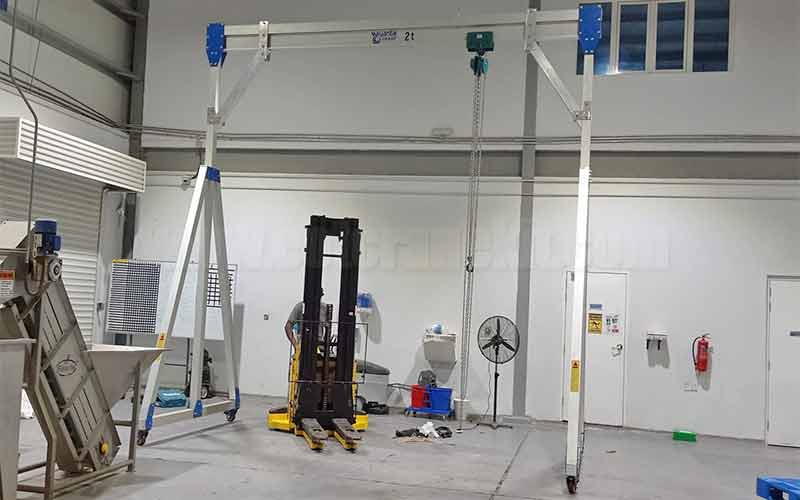
Cleanroom Considerations
Aerospace manufacturing often involves the assembly of components in cleanroom environments to prevent contamination. Gantry cranes in the aerospace industry must adhere to specific cleanroom considerations, including:
- Cleanroom Compatibility: Gantry cranes designed for cleanroom environments should be constructed using materials that minimize the generation of particles and are easy to clean.
- Sealed Components: Components and mechanisms should be sealed to prevent the release of contaminants, ensuring compliance with cleanroom standards.
- Stainless Steel Construction: Utilizing stainless steel in crane construction enhances cleanliness and corrosion resistance, making it suitable for aerospace cleanroom applications.
- Airflow Considerations: Gantry crane design should minimize airflow disruption to maintain the integrity of the cleanroom environment.
Understanding the need for precision and cleanliness in the aerospace industry allows for the selection of gantry cranes that meet stringent requirements, ensuring the safe and efficient handling of delicate components within cleanroom environments. In the subsequent sections, we will explore specific considerations for gantry crane selection in other industrial sectors, providing comprehensive insights for buyers across diverse industries.
Construction and Infrastructure
Mobility and Adaptability on Construction Sites
In the construction and infrastructure sector, gantry cranes are essential for lifting and moving heavy materials and equipment on dynamic construction sites. Specific considerations for mobility and adaptability include:
- Mobile Gantry Cranes: Opt for gantry cranes with mobile configurations, allowing them to be easily relocated to different areas of the construction site based on project requirements.
- All-Terrain Features: Gantry cranes with all-terrain capabilities can navigate challenging and uneven surfaces commonly encountered in construction sites, enhancing their adaptability.
- Quick Assembly and Disassembly: Construction projects often demand rapid deployment and removal of lifting equipment. Gantry cranes with quick assembly and disassembly features contribute to overall project efficiency.
- Stability on Varying Ground Conditions: Ensuring stability on diverse ground conditions, such as soft soil or gravel, is crucial for safe and reliable crane operation.
Handling Large and Irregularly Shaped Materials
Construction sites often involve the handling of large and irregularly shaped materials, requiring gantry cranes with specific capabilities. Considerations include:
- High Lifting Capacity: Gantry cranes in construction must have a high lifting capacity to handle heavy construction materials like steel beams, concrete panels, and prefabricated components.
- Extended Reach: Choose gantry cranes with extended reaches or boom configurations to reach over obstacles or navigate within complex construction layouts.
- Adjustable Configurations: Gantry cranes with adjustable configurations, such as telescopic booms or variable height features, accommodate the lifting of materials with varying dimensions.
- Material Protection: Incorporate features to protect materials from damage during lifting and transportation, ensuring the integrity of construction components.
Understanding the unique demands of construction and infrastructure projects allows for the selection of gantry cranes that enhance mobility, adaptability, and efficiency on construction sites. In the subsequent sections, we will explore specific considerations for gantry crane selection in other industrial sectors, providing comprehensive insights for buyers across diverse industries.
Maintenance and Safety
Regular Maintenance Routines
Scheduled Inspections and Lubrication
Regular maintenance is crucial for ensuring the longevity and safe operation of gantry cranes. Establishing a comprehensive maintenance routine includes:
- Scheduled Inspections: Regularly inspecting critical components such as hooks, ropes, trolleys, and structural elements to identify signs of wear, damage, or corrosion.
- Lubrication: Applying appropriate lubricants to moving parts, such as wheels, gears, and bearings, to reduce friction and prevent premature wear.
- Electrical System Checks: Inspecting and testing the electrical components, including wiring, control panels, and sensors, to ensure proper functionality.
- Alignment Verification: Checking and aligning the crane's components to maintain optimal performance and prevent issues related to misalignment.
Importance of Operator Training
Comprehensive Training Programs
Operator training is paramount to ensure the safe and efficient use of gantry cranes. Key considerations for operator training include:
- Comprehensive Programs: Implementing thorough training programs covering crane operation, safety protocols, emergency procedures, and routine maintenance tasks.
- Hands-On Practical Training: Providing hands-on training to operators for real-world scenarios, allowing them to develop practical skills in operating the gantry crane.
- Safety Awareness: Emphasizing the importance of adhering to safety guidelines, load capacity limits, and proper communication practices between crane operators and other personnel.
- Regular Refresher Courses: Conducting regular refresher courses to keep operators updated on new safety standards, technological advancements, and best practices.
Compliance with Safety Standards and Regulations
Adherence to Industry Standards
Ensuring gantry cranes comply with safety standards and regulations is essential for preventing accidents and maintaining a safe working environment. Key considerations include:
- OSHA (Occupational Safety and Health Administration) Compliance: Adhering to OSHA standards, which provide guidelines for crane safety, inspection, and operator training.
- ANSI (American National Standards Institute) Standards: Following ANSI standards specific to gantry cranes to ensure proper design, construction, and maintenance practices.
- Local Regulations: Complying with regional or national safety regulations and standards that govern the use of gantry cranes in specific industries.
- Documentation and Records: Maintaining detailed records of inspections, maintenance activities, and operator training to demonstrate compliance with safety standards during regulatory audits.
Prioritizing maintenance routines, operator training, and compliance with safety standards is essential for creating a secure working environment and maximizing the lifespan of gantry cranes. In the subsequent sections, we will explore additional aspects of gantry crane selection and usage to guide buyers in making informed decisions tailored to their specific industrial needs.
Get Your Custom Gantry Cranes for Your Factory and Plants
In this comprehensive guide on factory gantry cranes, we've covered a multitude of factors essential for making informed decisions when purchasing gantry cranes for various industrial applications. Key points include:
- Understanding Different Types: From single girder to double girder, semi-gantry to portable cranes, each type has distinct features and applications.
- Considerations for Different Industries: Recognizing the specific requirements of industries like automotive, steel manufacturing, aerospace, and construction is crucial for selecting suitable gantry cranes.
- Environmental Factors: Addressing challenges posed by different working environments, such as dust-free areas, dusty environments, high-temperature settings, and cleanrooms.
- Space Constraints: Adapting gantry crane designs to fit limited spaces and choosing the right configurations for cramped environments.
- Load Capacity and Size: Calculating load requirements accurately and choosing gantry crane sizes that align with factory dimensions and lifting needs.
- Maintenance and Safety: Emphasizing the importance of regular maintenance routines, comprehensive operator training, and compliance with safety standards and regulations.
Selecting the right gantry crane involves considering a multitude of factors, and the guidance of experts in the field can provide personalized advice tailored to specific industrial requirements. Consulting with professionals ensures that the chosen gantry crane aligns perfectly with operational needs, enhancing efficiency and safety.
Main Projects
Related Products

Supplied three grab bucket crane kits to Indonesia, enhancing garbage handling efficiency with high load capacity and reliable performance.
Free consultation to Confirm Parameters & Specifications and Get
Latest Crane Price & Crane Rate.
- Types of overhead cranes : _______?
- Optional: Overhead travelling crane, goliath gantry crane,Slewing jib crane, Single girder or double girder crane,small portable crane or kbk crane, etc.
- Capacity of overhead crane: _______?
- Optional: 0.25ton, 0.5 ton, 1 ton, 2 ton, 3ton, 5 ton, 10 ton,15ton, 20ton, 25 ton, 30ton,35ton, up to 550ton, etc.
- Crane span & lifting height : _______?
- Crane travelling length : _____?
- Control of overhead crane:_______?
- Optional: pendant/ remote/cabin control
- Voltage supply of overhead crane:_____?
- Eg,: 380V50/60HZ,3Phase or others,etc.
- Application/usage of crane:_______?
- Eg,: Steel mill, ,injection mold, cement,stone, concrete,granite, general manufacturing, etc.
Just leave a message via the contact form and our hoist and crane engineer will contact you with in 24working hours.
Get In Touch
